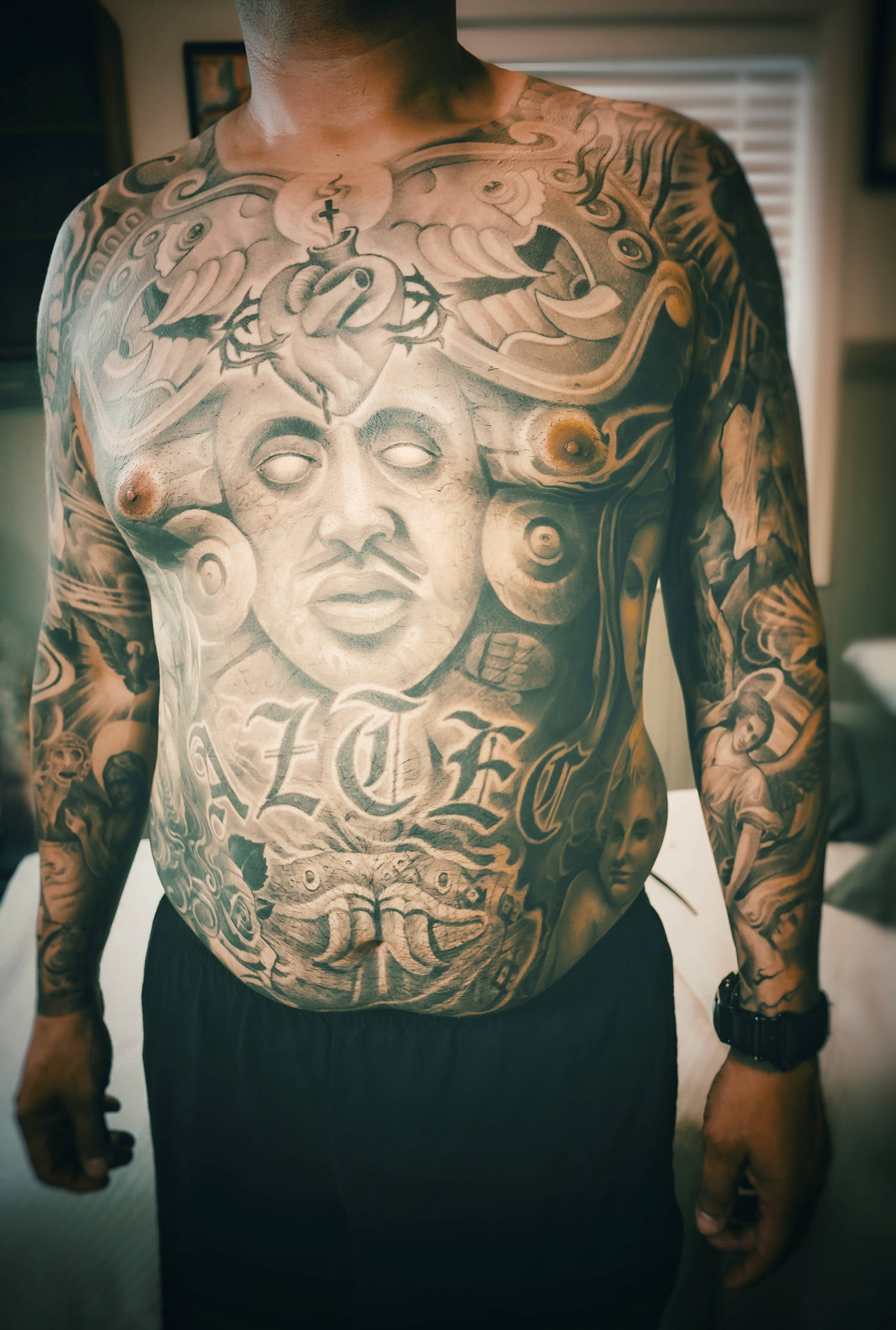
Although South California (especially Los Angeles) was already known for black-and-gray prison-style tattooing, in North California, Eddy Reyes Sr popularized Chicano art by mixing aspects of Mexican culture, religion, and history with the street vibe of the West Coast of the United States. His meticulously crafted body art, made with fine-line needles, displays a delicate balance of positive and negative space.
Secret Sidewalk Tattoos is the name of his shop, which has since expanded to Niles (Fremont), Tracy, and once was based in Hayward, California. The walls of the Niles establishment, which Reyes Sr inaugurated a month ago, are adorned with colorful artwork by his tattooer friends. The newest shop has the presence of Charlie Chaplin, an emblematic figure of Niles, who appeared in silent films at the Essanay Studios in the early 1900s and ultimately developed his renowned persona “The Tramp” there before relocating to the glittering heights of Hollywood.
Eddy Reyes Sr is a highly private individual who prefers face-to-face interaction and building a local community over social media. Classic cars are displayed in front of his stores on occasion, showing his enormous interest and collecting for them. Furthermore, Reyes Sr places a high value on family relationships; his wife Araceli works as his schedule manager, his daughter Julissa is an apprentice, and Eddy Jr and Fabian are tattoo artists at Secret Sidewalk.
This interview provides an overview of the life and career of Eddy Reyes Sr and the significance of opening in Niles after waiting more than two decades to do so.
Above: A bodysuit created by Reyes Sr pays homage to Mexica and Chicano cultures.
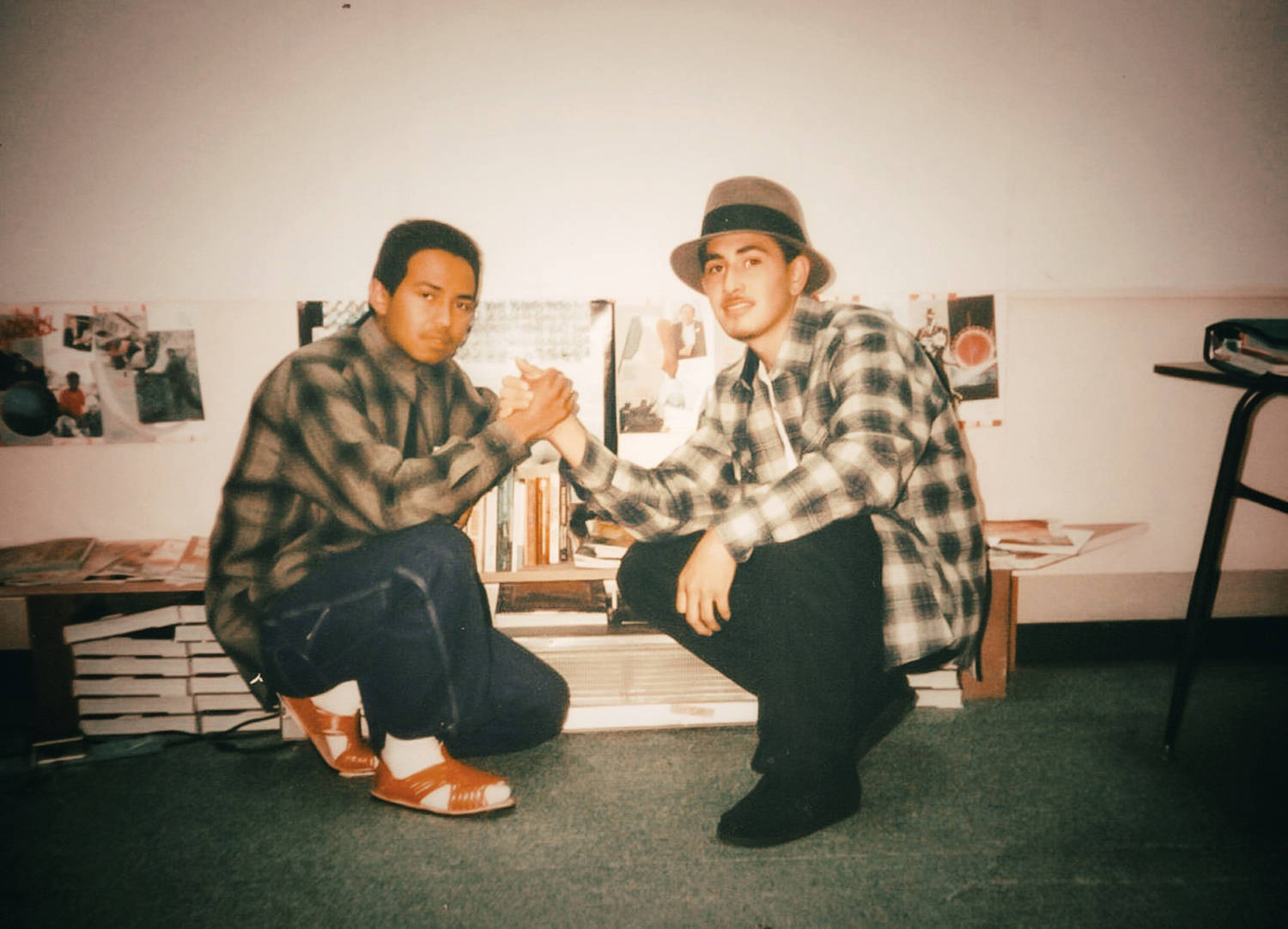
Young Eddy Reyes Sr in East Bay Area, California.
Why did your parents relocate from Mexico to the States?
They just wanted a better life, like everybody else, when they came to California, a better opportunity for all of us. I was two years old when we arrived in Southern California. And then my parents migrated up north, and we’ve been there ever since.
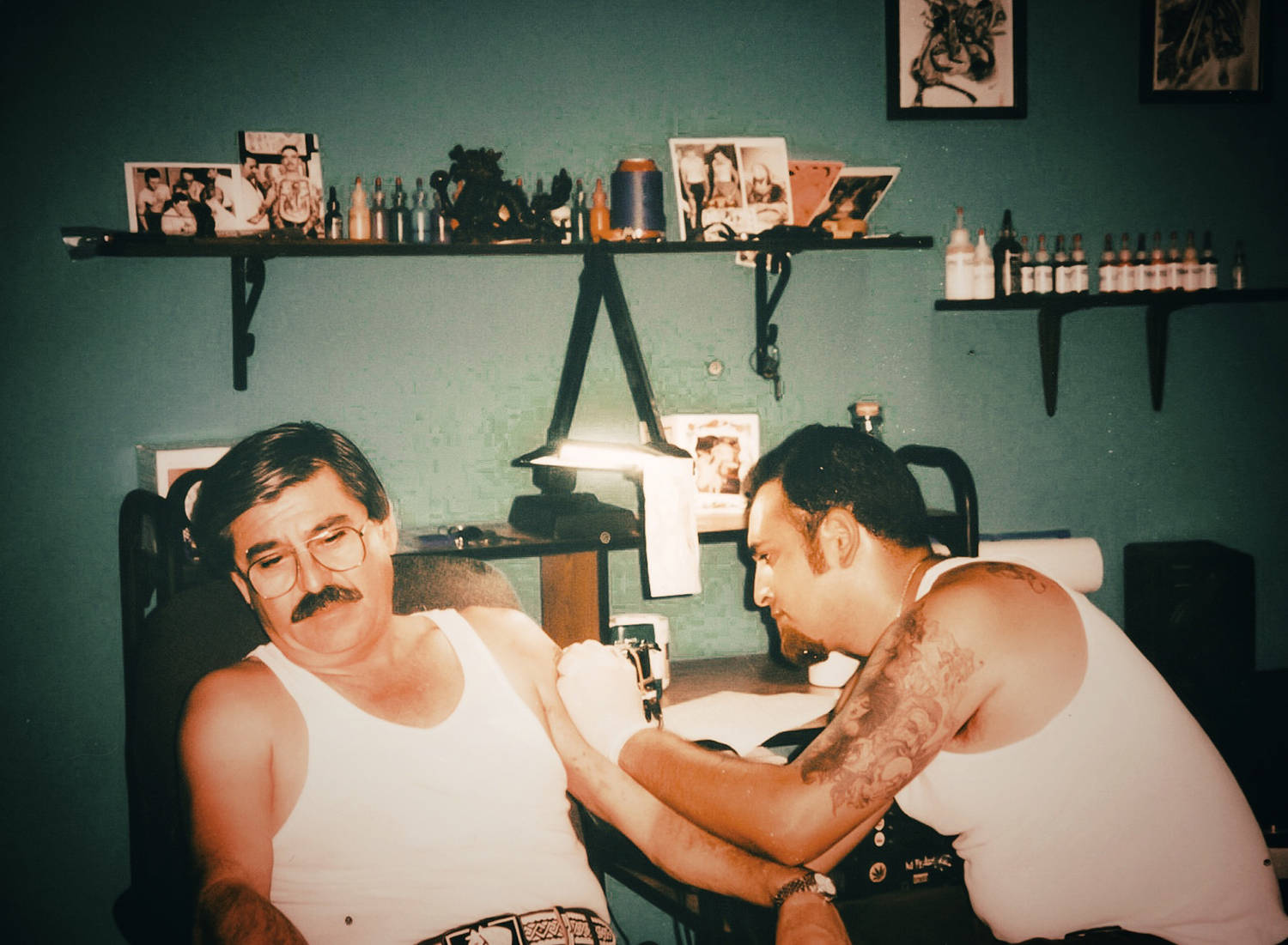
The beginning of Reyes Sr’s tattooing career.
How many siblings do you have?
It’s a lot. I’m the youngest one out of 11. My parents were already older when they had me. My mother was sick, and she was only around for a bit longer and then passed on. My siblings raised me, and that’s how I picked up tattooing. One of my older brothers (Ramon) had a tattoo on him, a Jesus face on his back. It was the first time I’d ever seen a tattoo, and I was crazy [fascinated] with it.
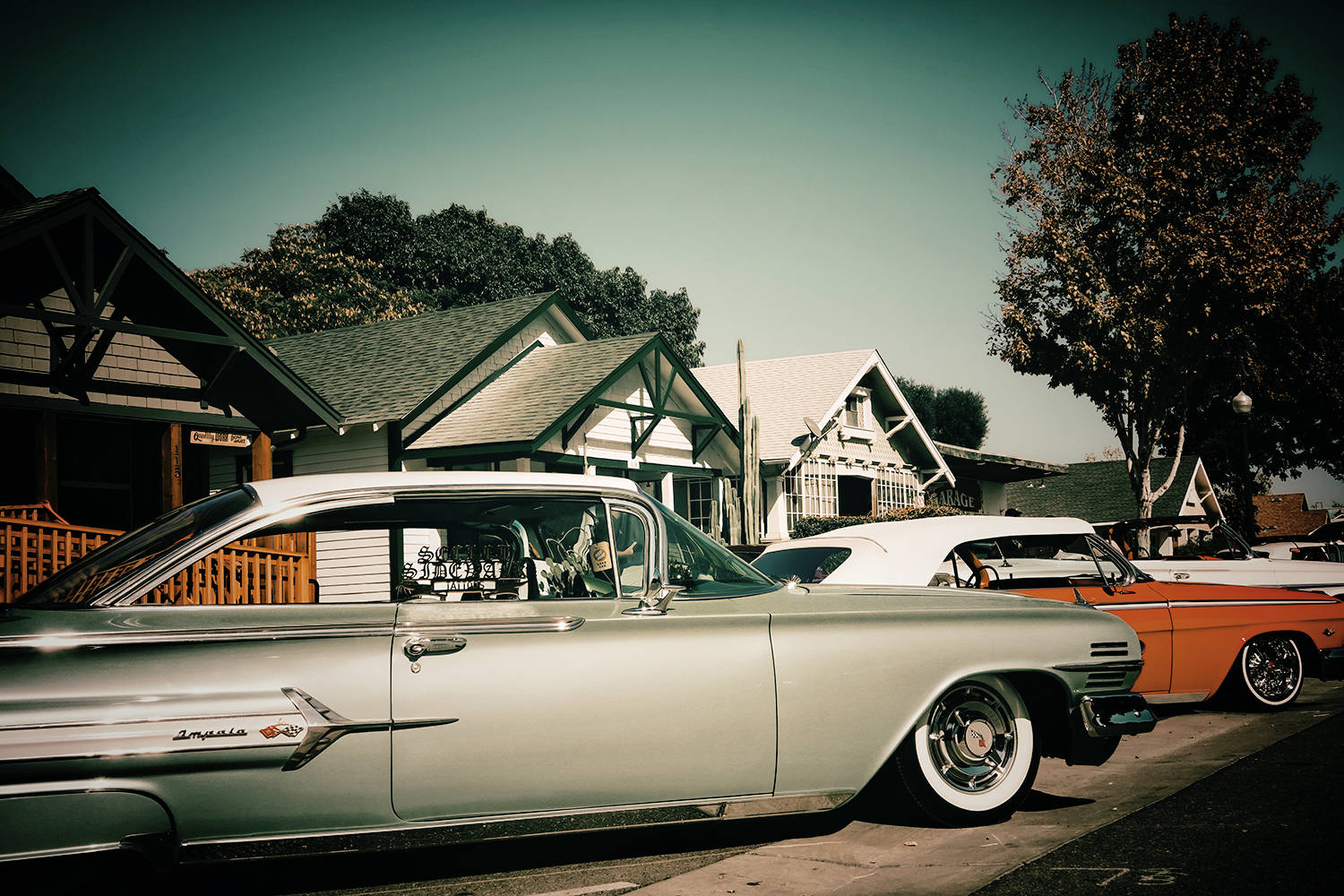
Eddy Reyes Sr and his sons’ classic automobiles are parked in front of the Tracy tattoo parlor.
Who did the Jesus tattoo?
The Jesus drawing was based on a postcard my mom sent to Ramon, and he got that image tattooed on his back in prison. Ramon didn’t want to discuss it, so my brother Teo explained it.
I kept asking, “How does that stain the skin? How did they paint it on you? Teo liked drawing and said, “It’s made with Indian ink.” I didn’t think much of it. But I walked into his room and saw a small bottle that said “Indian Ink,” I was like, “There it is, right there!”
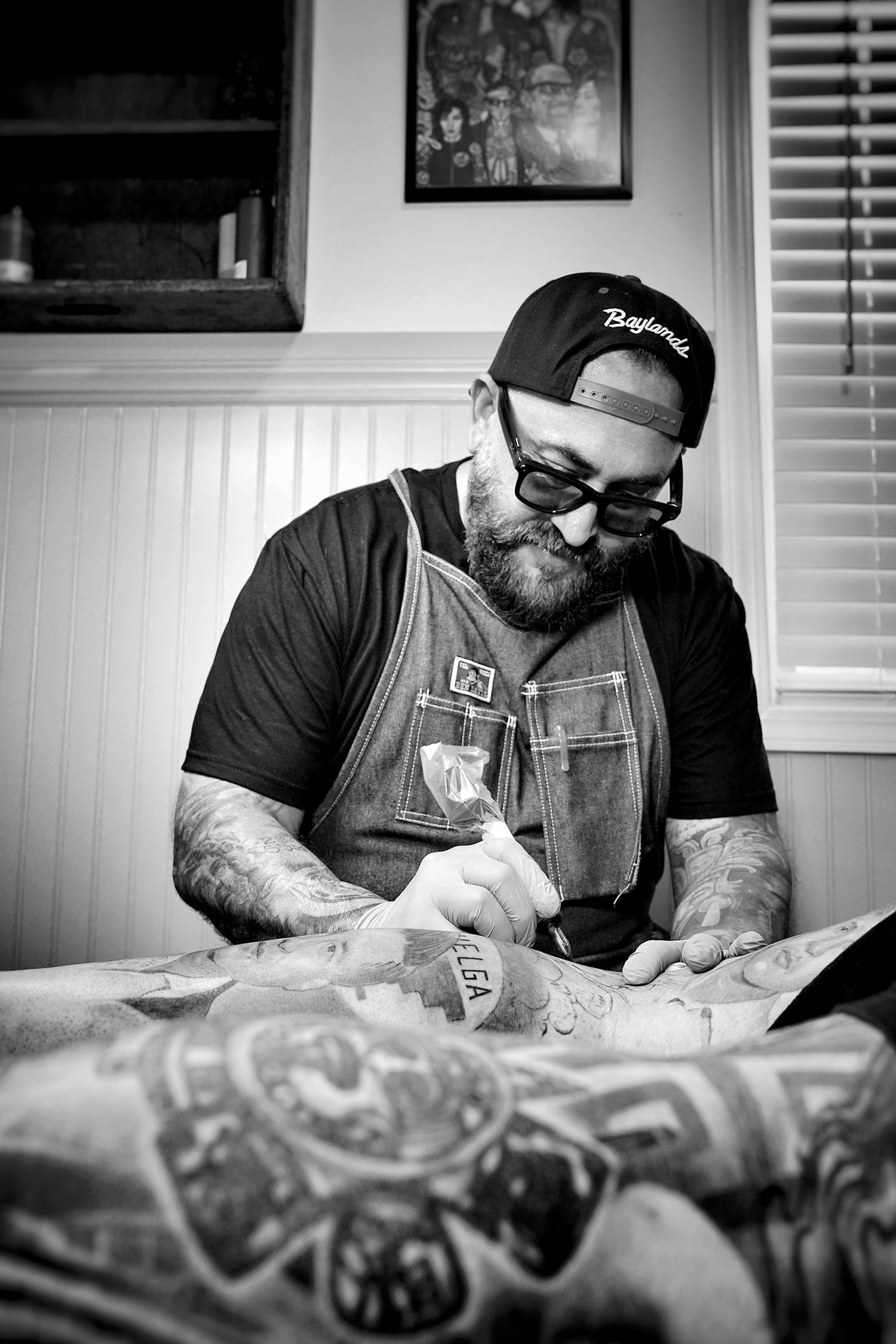
A room reserved for the Mexican-American legend (Reyes Sr) within the Niles’ establishment.
Did they use a guitar string as a needle?
Ramon’s tattoo was done with guitar string and gel. So I went to Teo’s room a week later and saw a bottle of Indian Ink; I grabbed it, poured it on my hand (with a little drop system), and then imprinted the letter “E” for Eddy. Thinking it would stain the skin. That’s how badly I wanted to see what it did; I didn’t understand tattooing then. (I was six or seven years old doing this, and never stopped chasing and learning the craft.)
Soon after, I ended up leaving for Mexico. This time, we visited family members and stayed for three years. My brothers were now grown up. I’m glad I went to Mexico because the school was different there; they taught me Aztec culture. I loved the history!
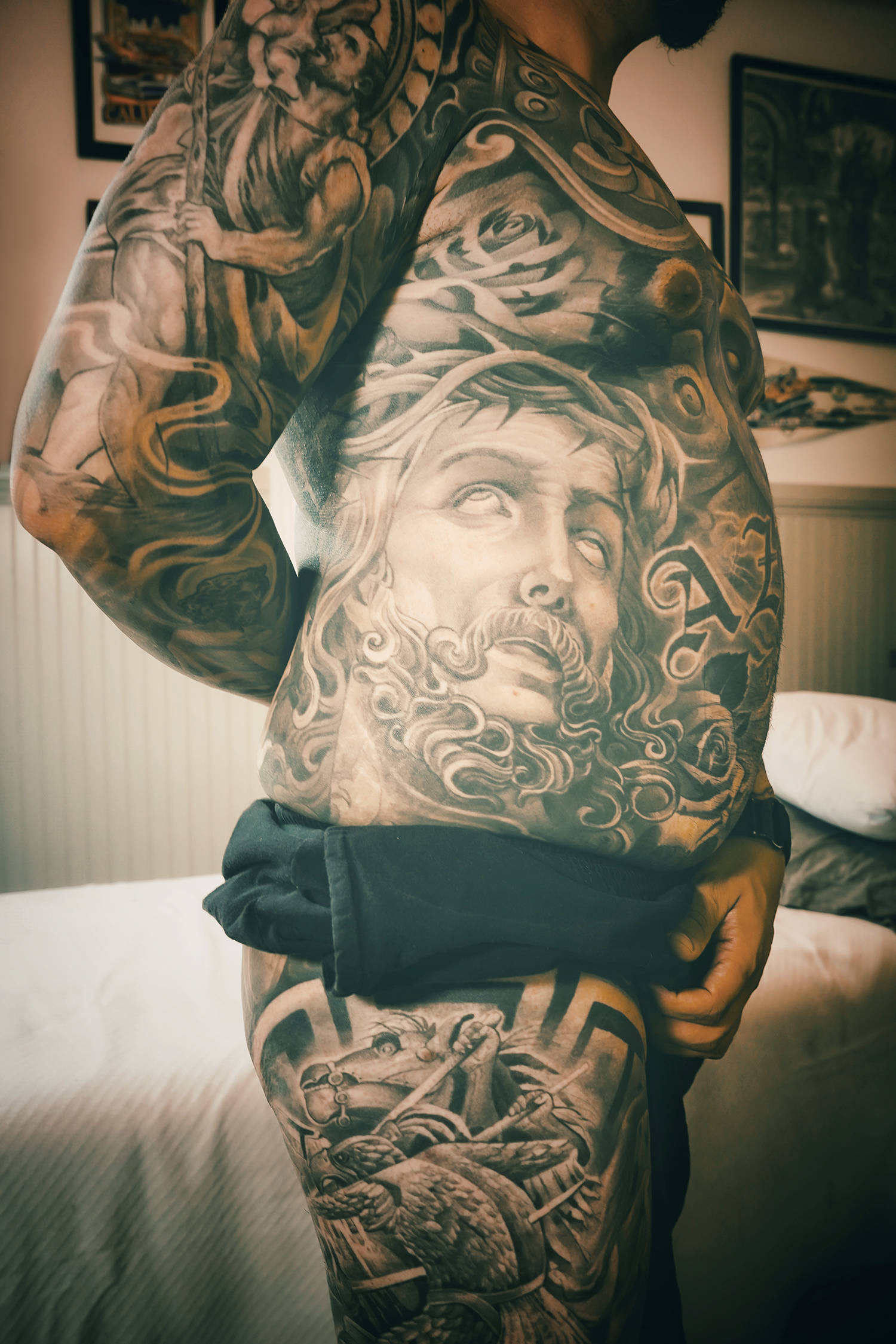
Jesus in black-and-gray refinement on client David.
Tattooing was still stigmatized.
Tattooing was not a thing in Mexico; I had never seen it there when I was a kid. Especially from the little town my family was from.
We then came back to the States. I stayed in Southern California with one of my brothers and was exposed to much more tattooing; there was a strong culture there. They had much tattooing in the San Diego area, mainly gangsters getting tattooed.
I wanted a “real” tattoo in fifth and sixth grade. I don’t know if it’s cool to say I was that little dude with tattoos, but it all fascinated me. One of my friends had an uncle who tattooed, more like street gang tattoos, and he had a homemade machine with a guitar string. My buddy called me out of nowhere and said, “Hey, you want one?” Of course, I wanted a tattoo! “My uncle left his machine here. He went back to prison.” I was like all over it! I tattooed my friend, and he did mine; it looked fine, and that was that.
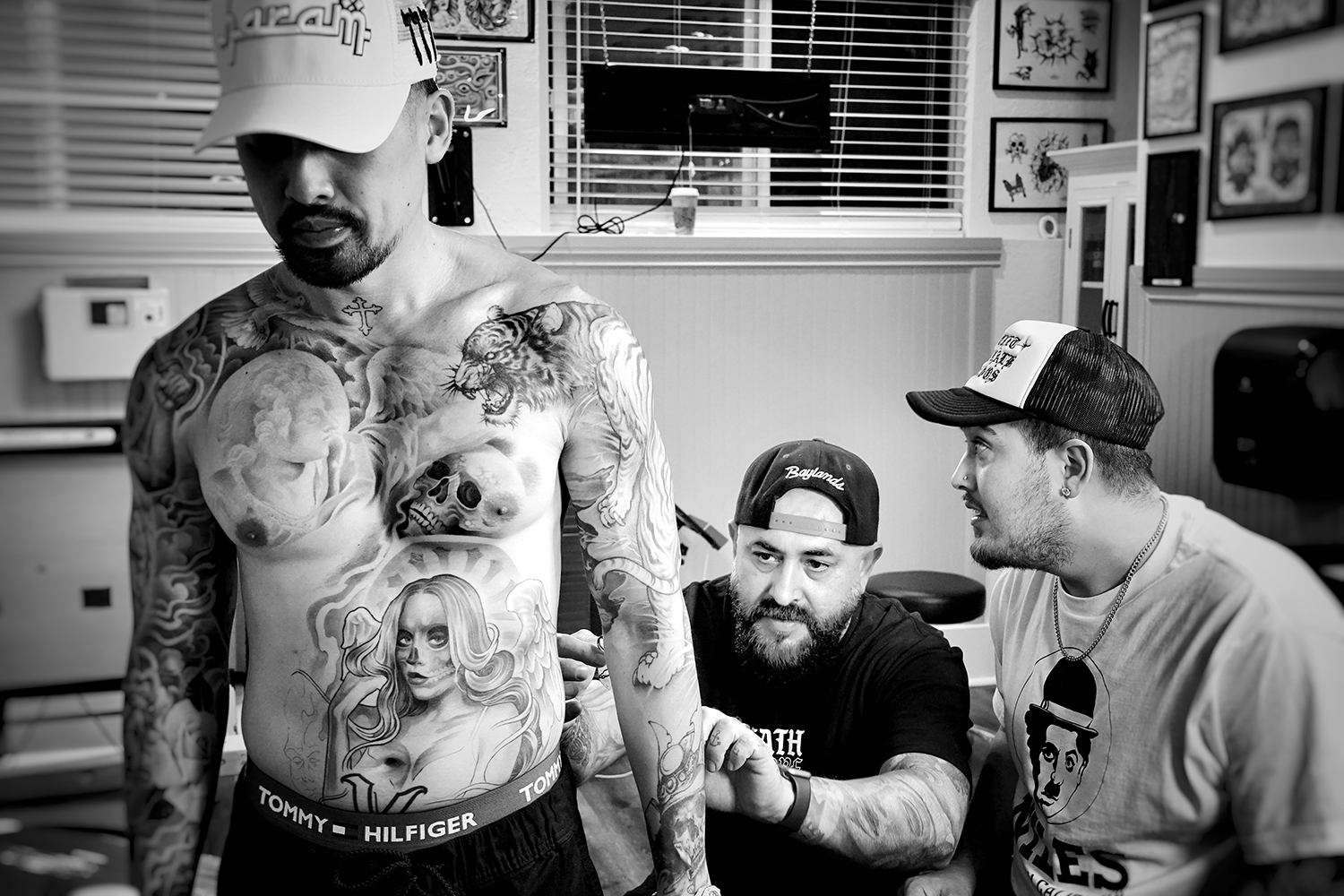
During Fabian Reyes’ tattoo session, his father provided advice.
You were now in the major leagues!
That’s it! After, I got tattooed by a local guy. He didn’t check IDs; it wasn’t a thing then. This tattooer was not an artist at all; you could go there and get tattoos from him and buy him [trade for] a beer, and he’d do it. The tattooer told me I had to draw the names for my tattoos. “This guy doesn’t know how to draw? Oh boy!” So, I drew my name and then my mom’s and father’s names for my chest. His tattooing hurt like it was deep in my heart. After watching him, I’m like, how can I do this too?
At 15, I was running around the streets, and that’s how I began tattooing. I got my practice because everybody didn’t care about nice tattoos back then. They just wanted to get tattoos and look cool and tough.
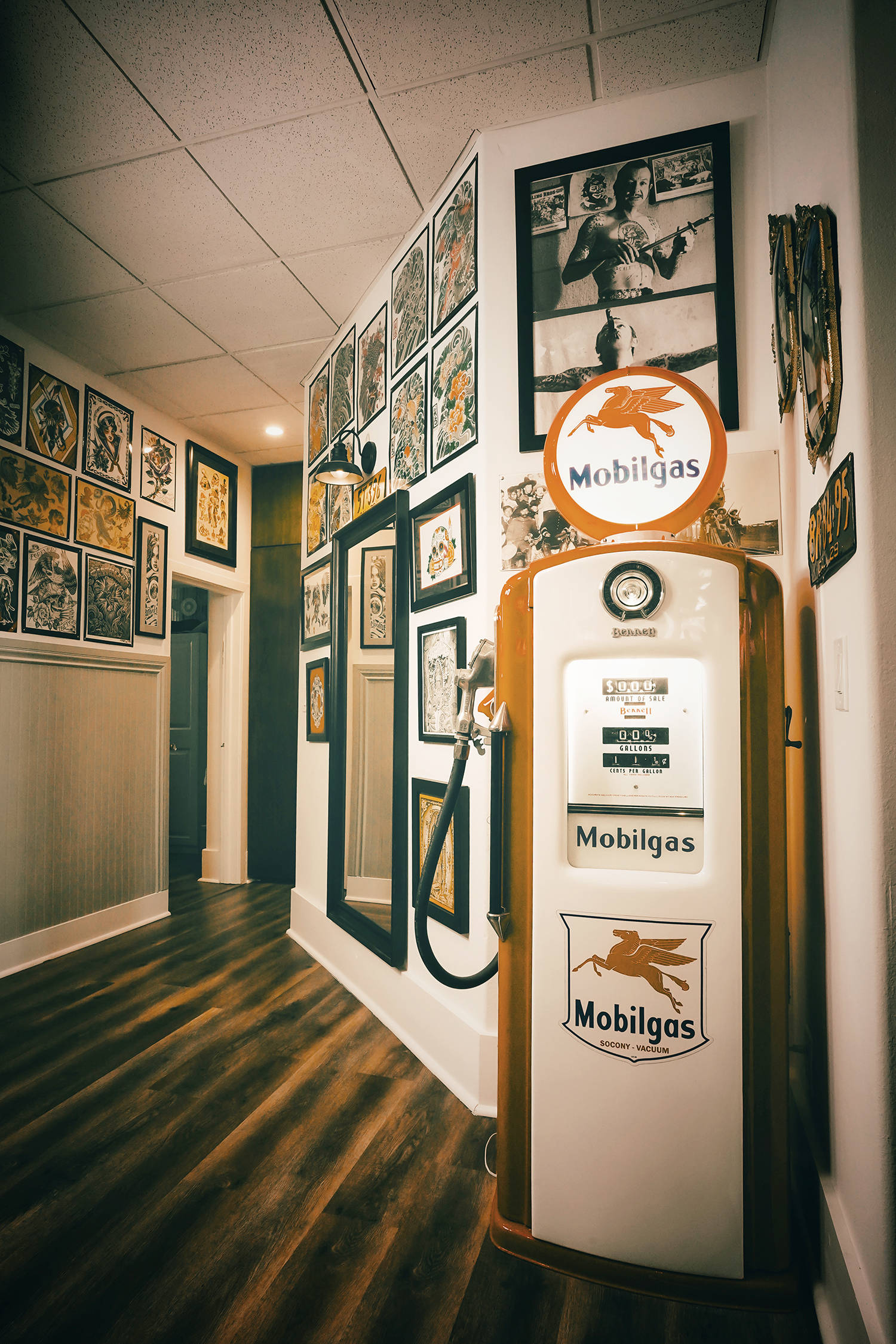
Captain Don Leslie and a gas pump from the 1950s embellish Secret Sidewalk in Niles, Fremont, California.
And you wanted to look “cool and tough” as well?
Yeah. Back then, only tough guys had tattoos. I would see the old Cholos that just came out of jail, sitting on the corner with the glasses on and mustache all tattooed up, and I’m like, I want to look just like that dude.
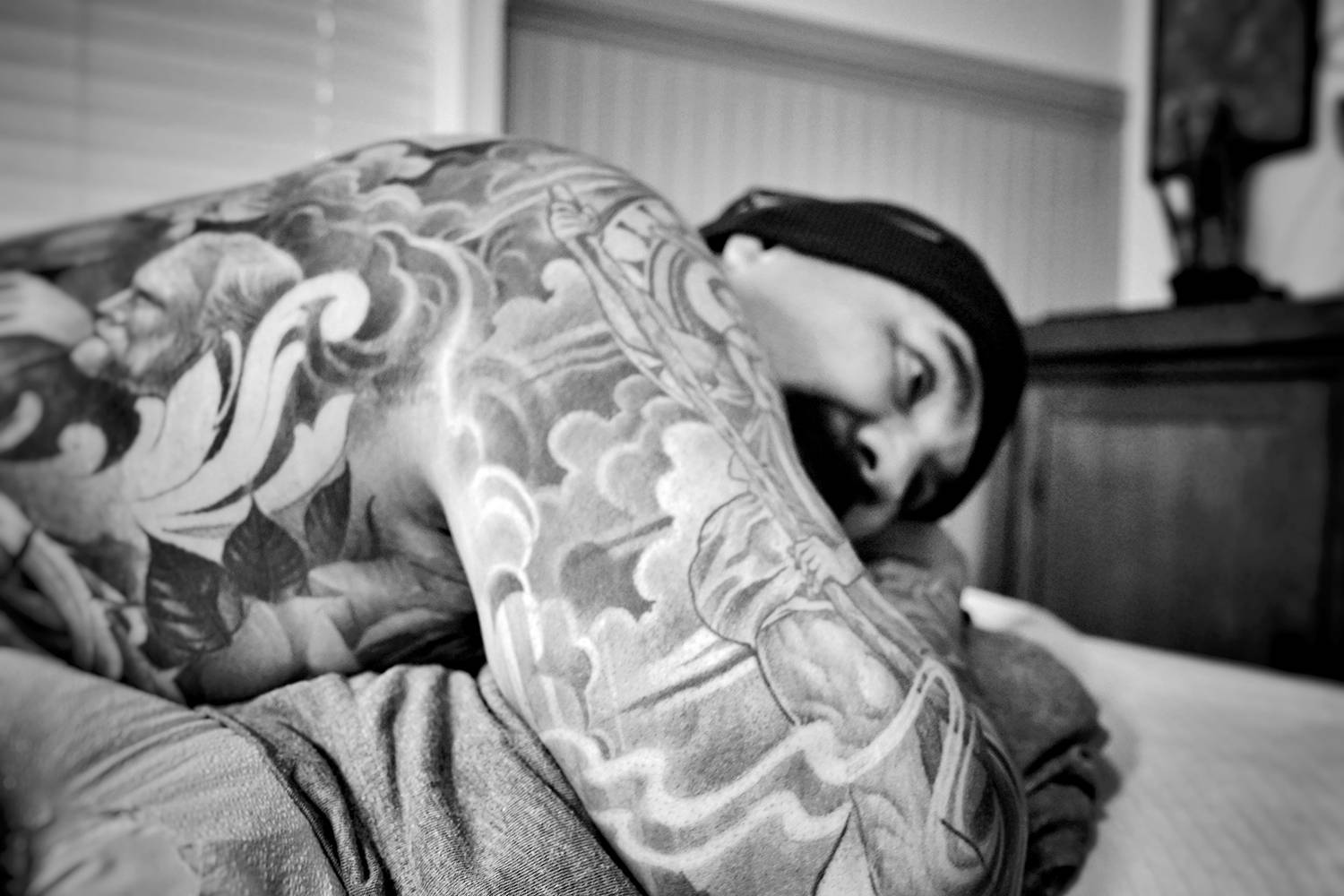
David, a client who visits Reyes Sr weekly for tattooing, was impressed by the shop’s atmosphere and the legend’s artwork.
It was a whole movement going on, part of the Mexican-American subculture.
A whole culture! The culture of the lowriders. I came here at the right time. My buddies always tell me that you grew up at the perfect time when lowriding was becoming a big thing. Brown and proud! Hip hop was in, and all that influenced me a lot, too.
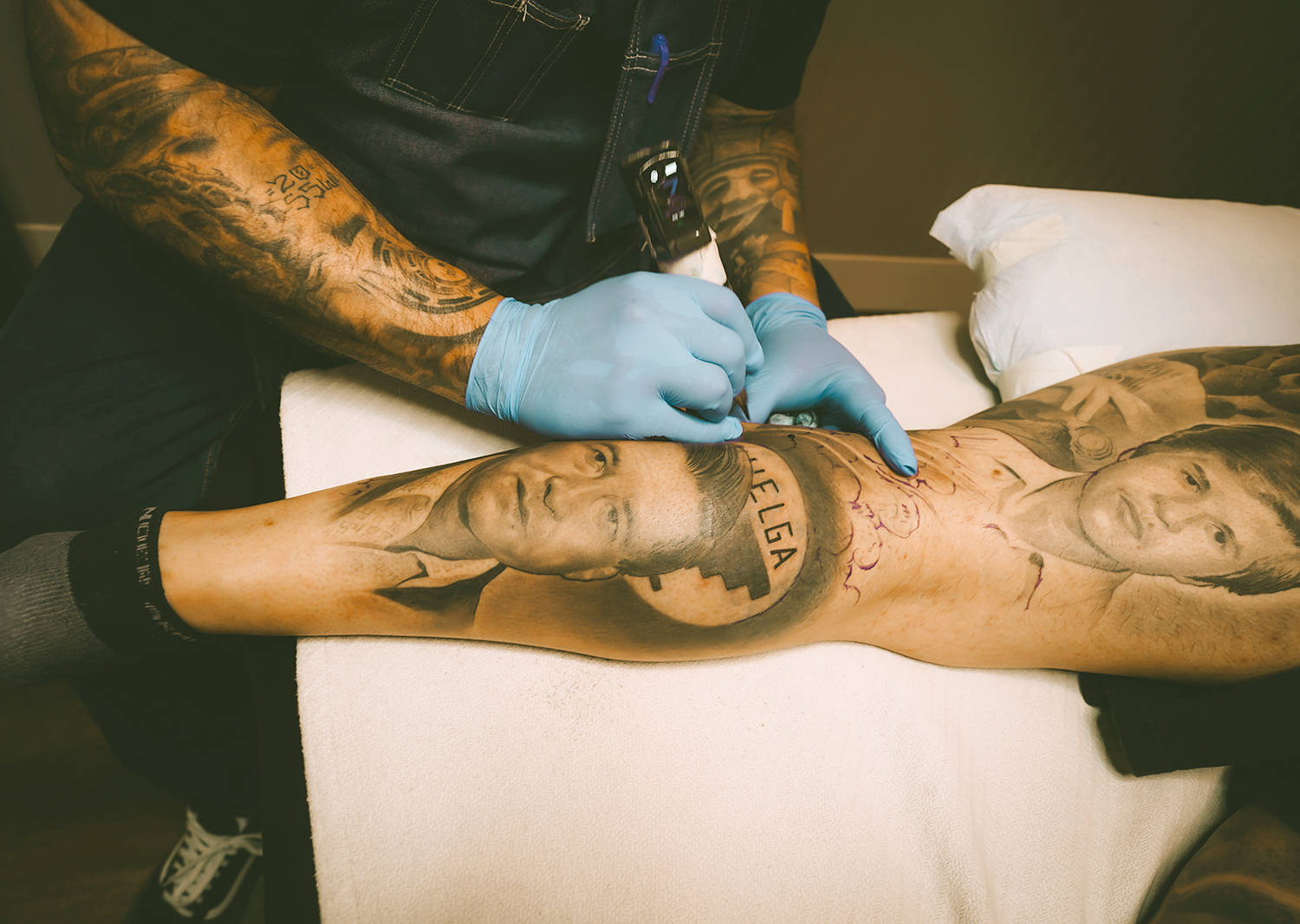
A portrait of the “folk saint” Cesar Chavez in the eyes of the Mexican-American community.
It was also a highly creative and adaptable generation in which tattoo artists made their inks and equipment.
You had to use your brain to make stuff, so we made our tattoo machines. My friend and I would go to different neighborhoods around the East Bay Area, from Oakland, Hayward, San Leandro, and San Francisco. We’d bring our tattoo equipment, and we tattoo anybody getting initiated into a gang or not even that; they just wanted to get tattoos and have that look.
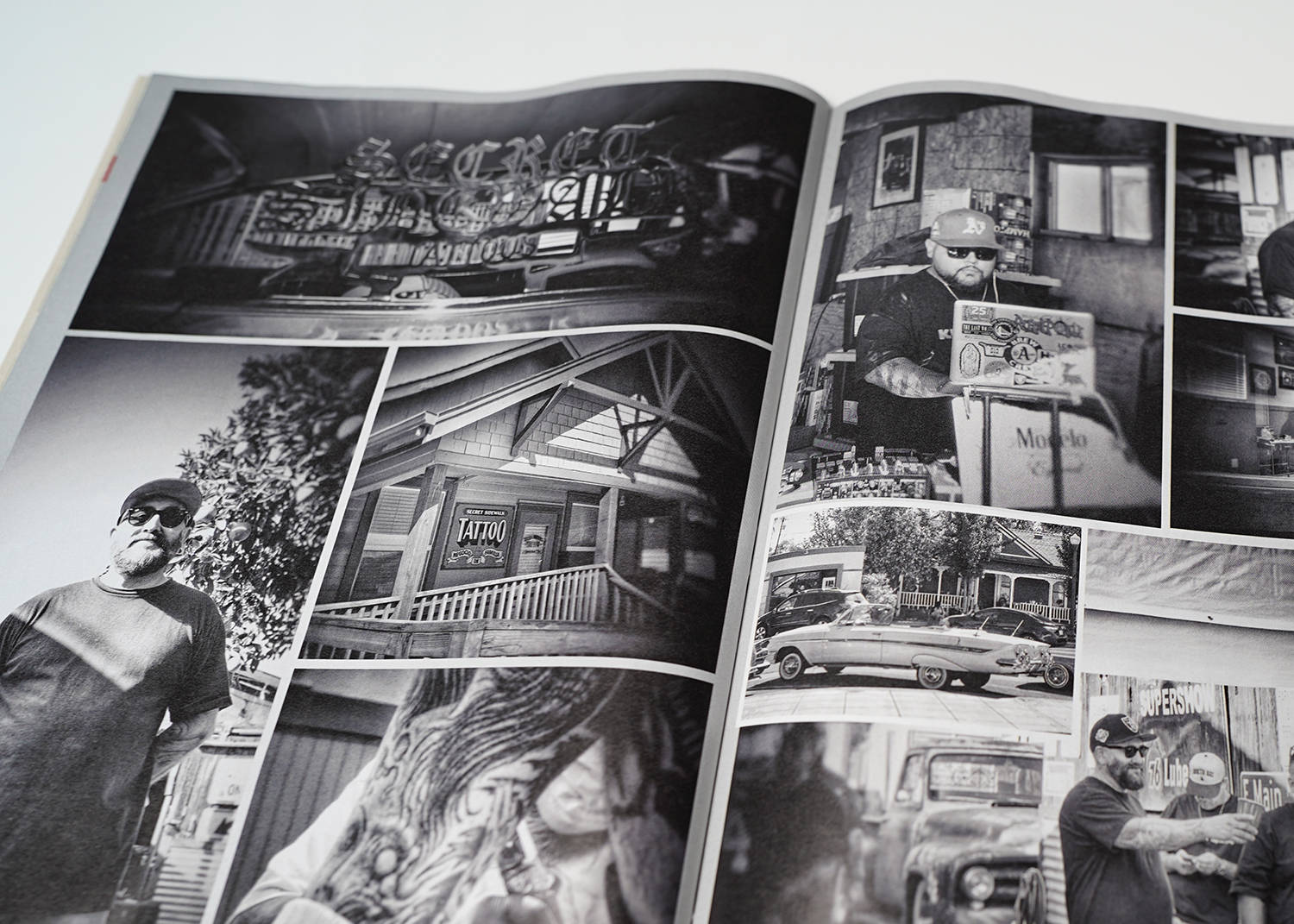
A former Tattoo Revue magazine feature written by The Tattoo Journalist detailing the Secret Sidewalk’s opening in Tracy, California.
Who were some of your most significant tattooing influences and supporters in the community?
I learned and got inspired by guys from the streets. There was a guy named Mosquito, a neighborhood tattoo artist, who did beautiful work. I looked at his tattoos and wanted to imitate what he was doing. Tattooers from the street are legends to me. When I started buying magazines, only then did I read about Jack Rudy, Good Time Charlie, and others in the tattoo world.
Bill Salmon was the owner of the Diamond Club in San Francisco. He and Junii have been running it for a long time. I used to read about him and everybody out of San Francisco: Henry Goldfield, Ed Hardy, Eddy Deutsche, Freddy Corbin. I used to know these people from magazines, but I was tattooing at a Sacramento convention, and Bill walked up to my booth and said, “Hey, do you want to go get a beer?” Even though I was tattooing, it was Bill talking to me. I never met or spoke to him; I just waved at him a few times here and there. So yeah, let’s talk for a minute. We went and had a beer. Then he started talking to me, saying he was proud of me for starting my tattoo shop in the Bay Area with black and gray tattooing. He told me about Jack Rudy and everybody at Good Time Charlie. Bill was the one that pretty much introduced me to everybody.
People would walk up to Bill, and he’d be like, “Hey, have you met Eddy?” They reply, “No, I haven’t.” “Well, this is Eddy Reyes. He owns Secret Sidewalk Tattoos.” I got a lot of love from him and his wife, Junii. So yeah, Bill helped me, and I am very thankful for that.
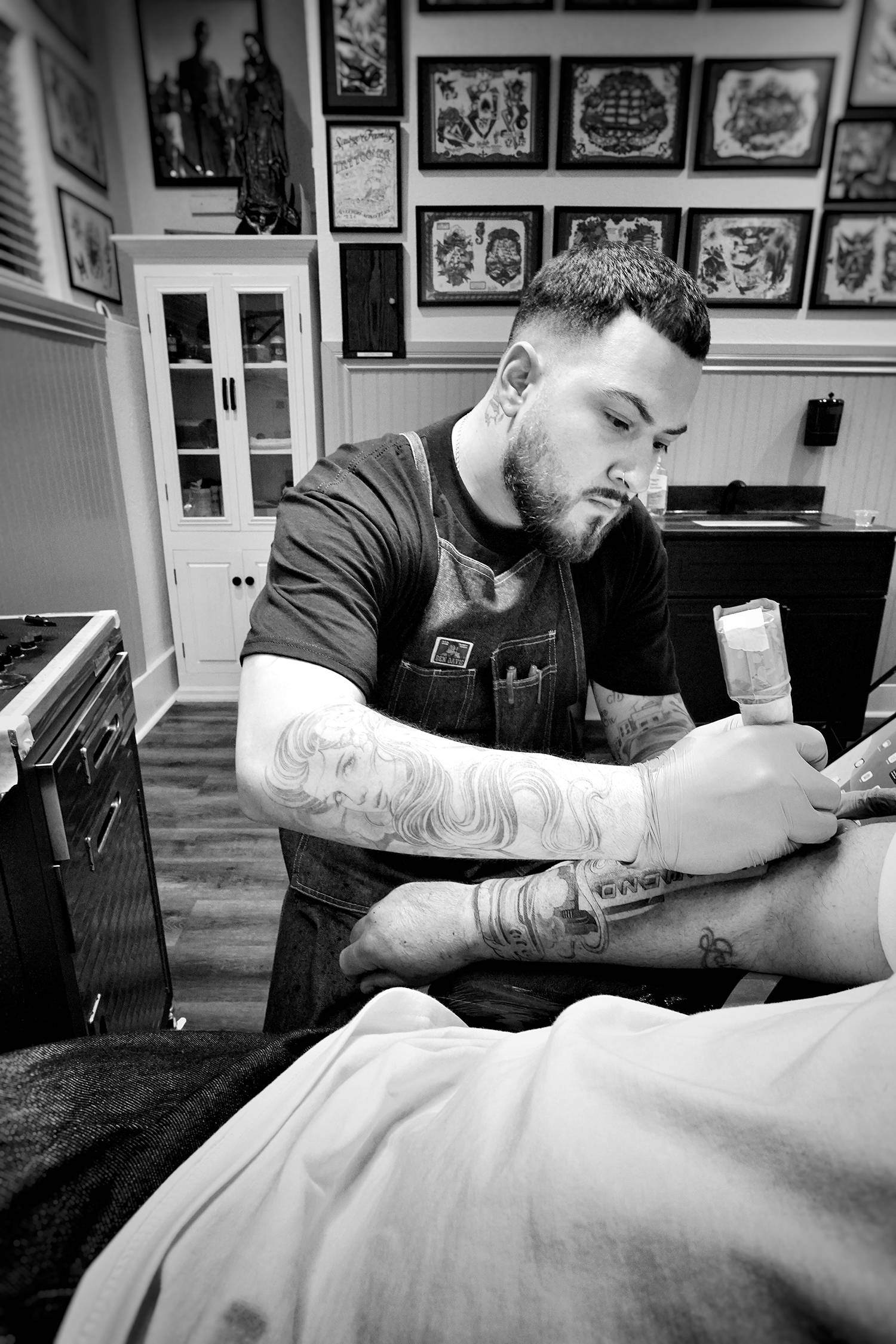
Customer Steve Auer paid homage to his son Lorenzo by having Eddy Reyes Jr tattoo the 1947 San Lorenzo sign.
Was tattooing your only job as a young adult?
I never thought about it as being a career. I was doing big-letter tattoos on my friends for fun. I quit tattooing because I had never seen it as a business. It was just a part of my lifestyle. But in the nineties, a lot of our friends were in gang stuff that affected many people we were growing up with. So, if you wanted to continue tattooing that style, people thought you were affiliated.
I got married at a young age and then had my daughter, so I quit tattooing for a regular nine-to-five job, working at Costco, driving a forklift, and paying bills. I also did airbrushing for cars.
I got discovered by a local tattooer named Advance (real name Vince), who worked by himself in a shop he owns in Fremont, California. He had seen my tattoo work when I was 16 and later told a family member of mine to ask Eddy to call him (I was about 18/19 then). My wife knew I wasn’t tattooing anymore and said you are going to call for what, “Tattooing a bunch of people that ain’t going to pay you for that kind of stuff.” We both didn’t know then that it could become a career.
I called and met Vince, and he said, “You got talent; you should put it to work.” I was excited and thinking, “Really? Can I work here with you?” He goes, “No, I like working by myself.” But I badly wanted to do the flash off his wall because Vince did every tattoo style. Vince explained I should stick to my current style, that Cholo stuff. “Stick to it. You’re going to be successful!”
Vince let me bring in more of my work to show him. He told me to order tattoo machines and bring them in, and he taught me how to use them, take them apart, and put them back together again. And I began tattooing out of my house, using a three-liner. With time, I got hired at another shop.
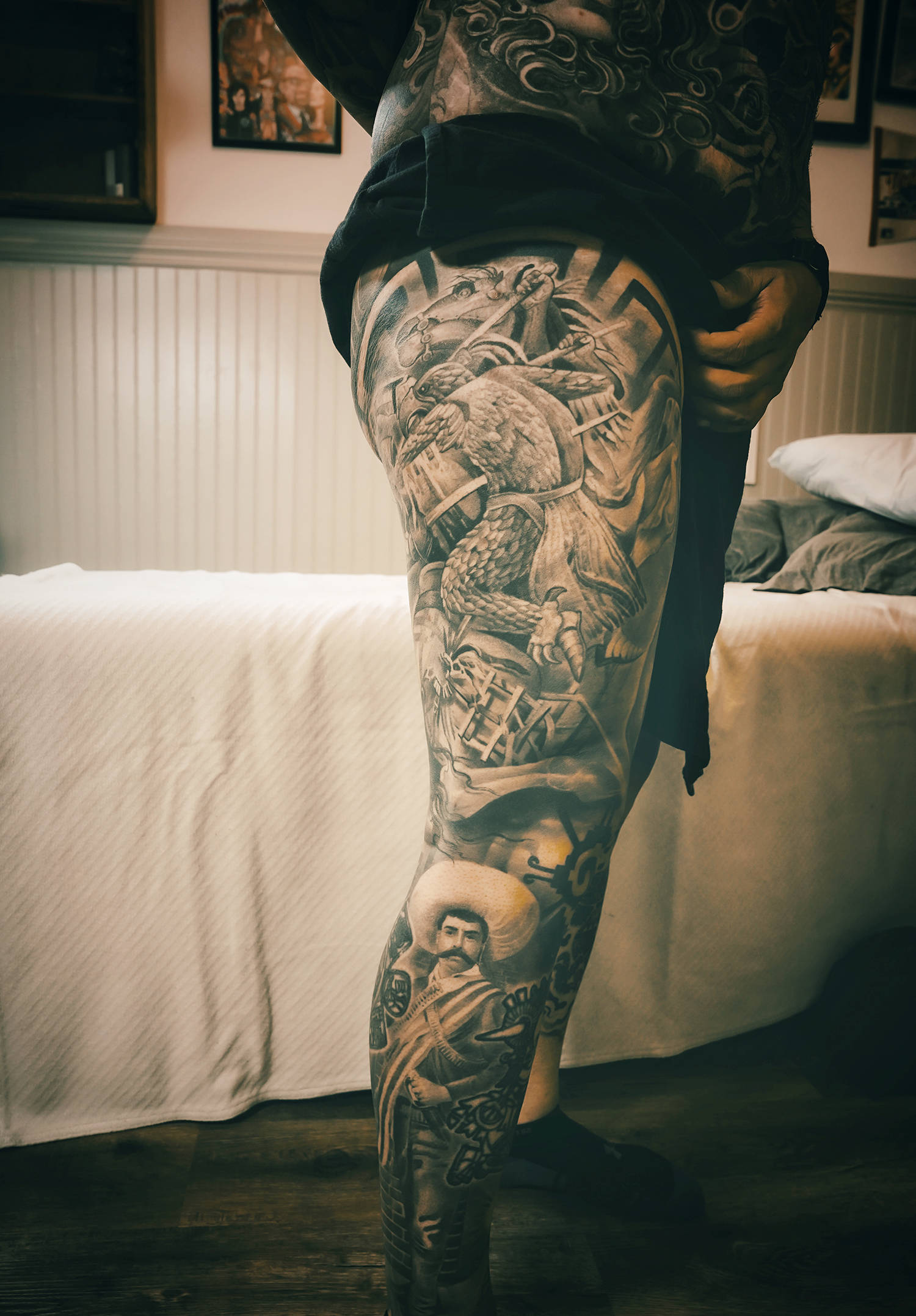
“The Bird Man” presents a tribute to Mayan art.
What shop was this?
A tattoo shop full of gangsters. I was trying to get away from that and ended up at this place where we were right next to AA meetings, alcohol around, and people wanting to help me. And we all used the same bathroom, and there were drugs. I couldn’t work there, so I opened my shop.
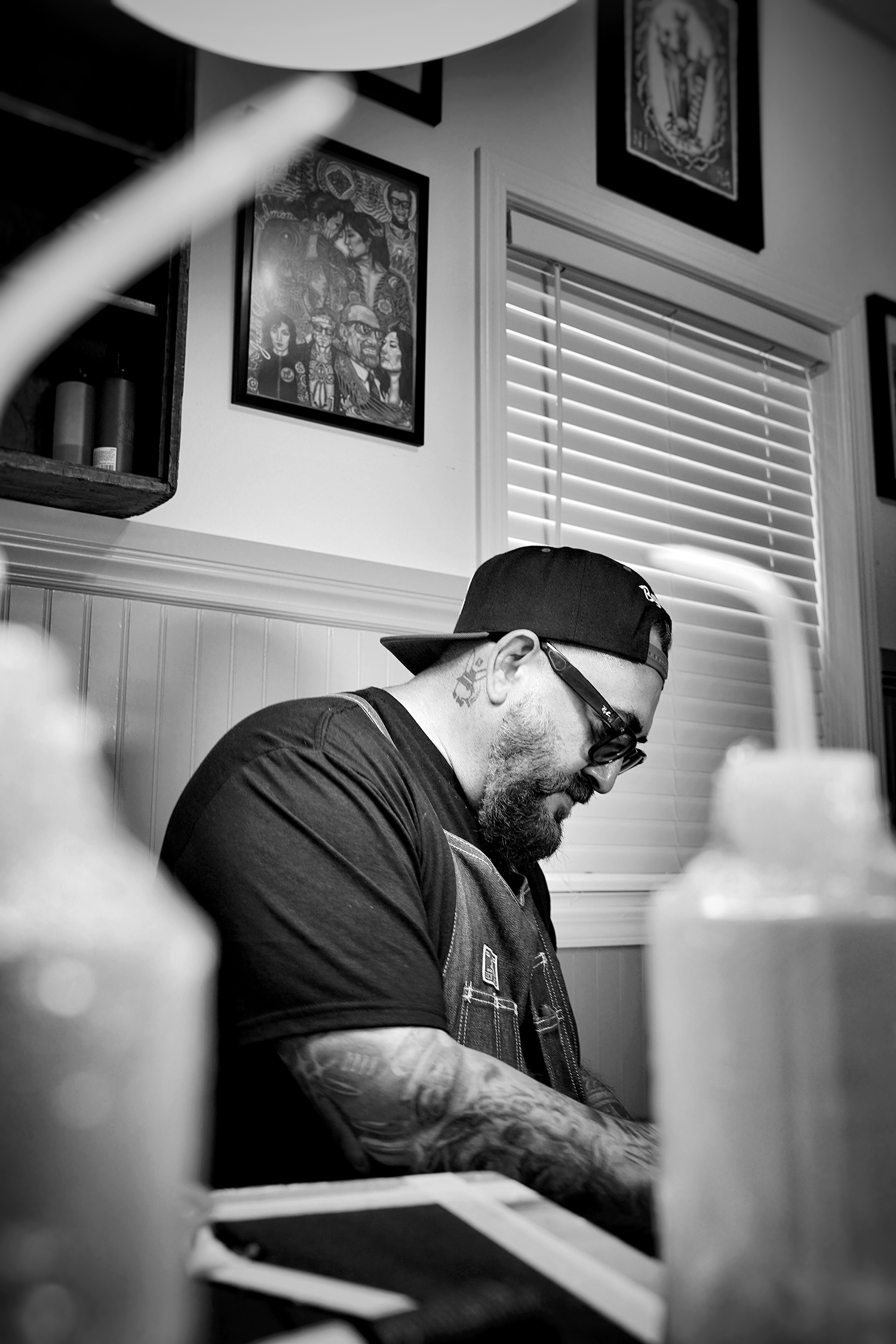
Reyes Sr wears a Playboy Bunny logo on his neck to symbolize his tattoo family, the Players Tattoo Club.
As a result, you trailblazed in black-and-gray tattooing within a professional parlor in North California.
2002, we opened the first Mexican tattoo shop in the Bay Area. Nothing in the Bay Area promoted Chicano culture. Everything was still done on the streets in the late 1990s and early 2000s. I would likely be tattooing Mexicans for the rest of my life, so I had to learn how to talk to them. “Hey bro [client], don’t bring your gang shit here. This is my business and how I feed my family,” literally to all of them to have respect for each other. And we tattooed the whole Bay Area after that. (Vince would send clients to my shop. And still, to this day, we are great friends.) I also did all this because I wanted a change for my kids and those I knew. Having a shop, and you get paid for your art.
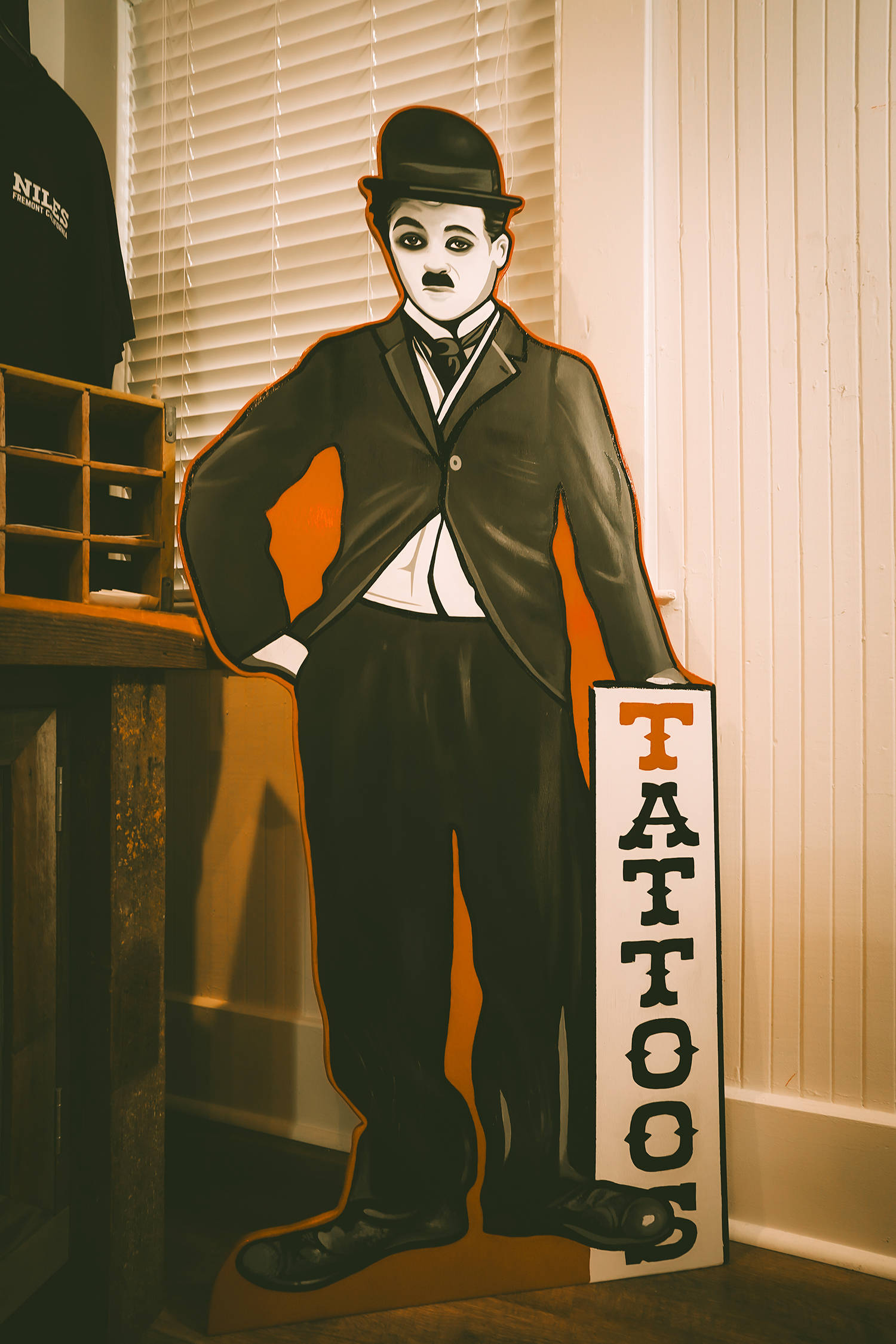
Charlie Chaplin is on display at the parlor in Niles.
You were soaring!
Oh yeah! I got invited to many conventions (Europe, etc). From the LA events, we were like, “We’re trying to get together and promote Chicano work, but we want to promote people from the streets, but without the gang shit.” I was trying to promote the art of it, which resulted in making a tattooer group to travel around promoting Chicano black and gray. Seeing Northern and Southern California artists teaming up was unexpected, but we were united.
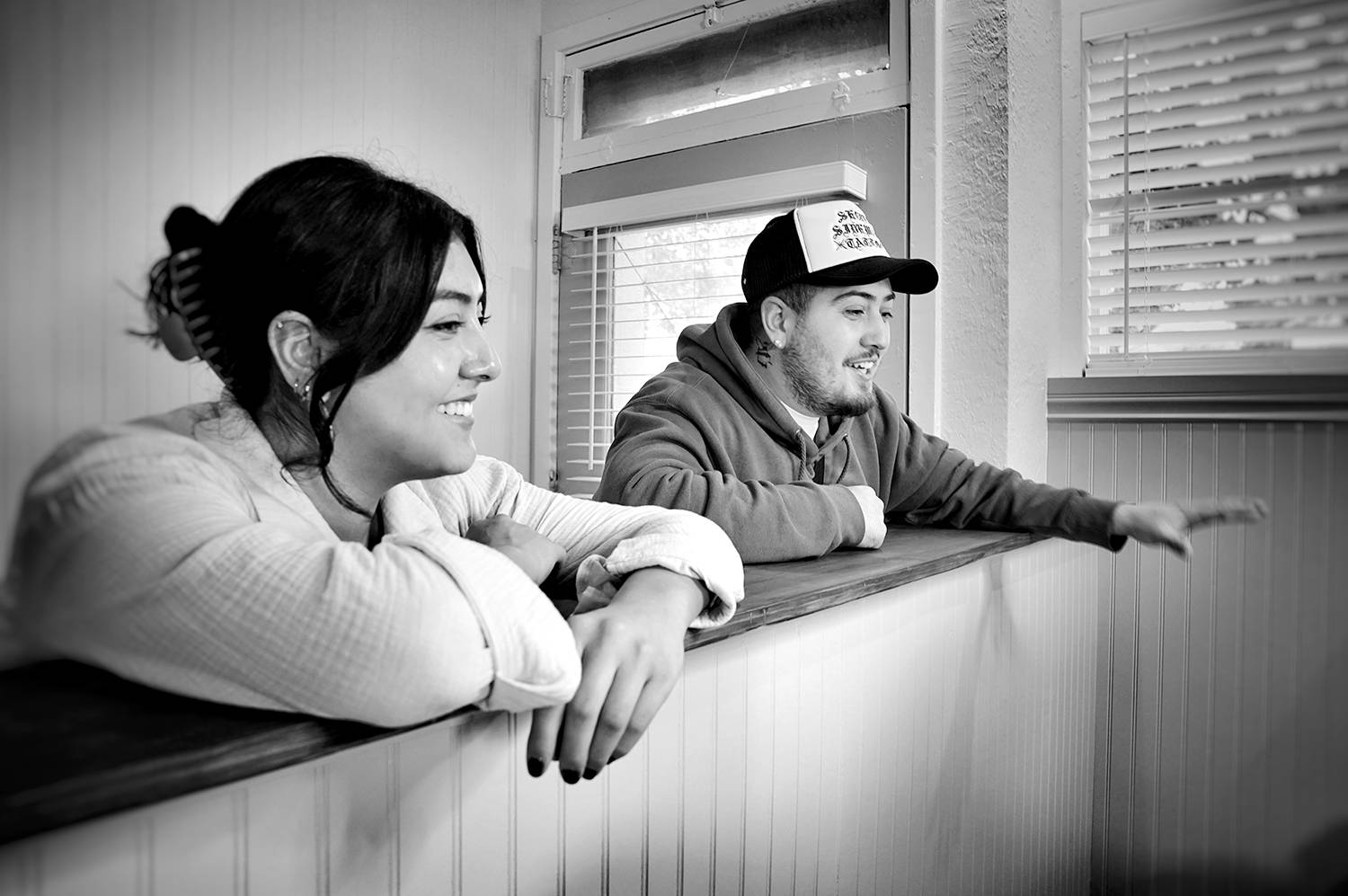
Daughter Julissa and son Fabian at the Niles studio.
How did the name “Secret Sidewalk” come to be?
I lived off and on in Niles (Fremont) when I was a kid. It is related to Niles Canyon Aqueduct, where people would go dating or smoke a joint or getaway at the time. It was an excellent hiding spot to party when you were a kid. Everybody knew the name of this location since the seventies. “Oh, the Secret Sidewalk,” they would shout out. And I grew up with another artist in the streets, and we met in Niles. We tried opening in Niles two decades ago, but Fremont did not allow tattooing as a business.
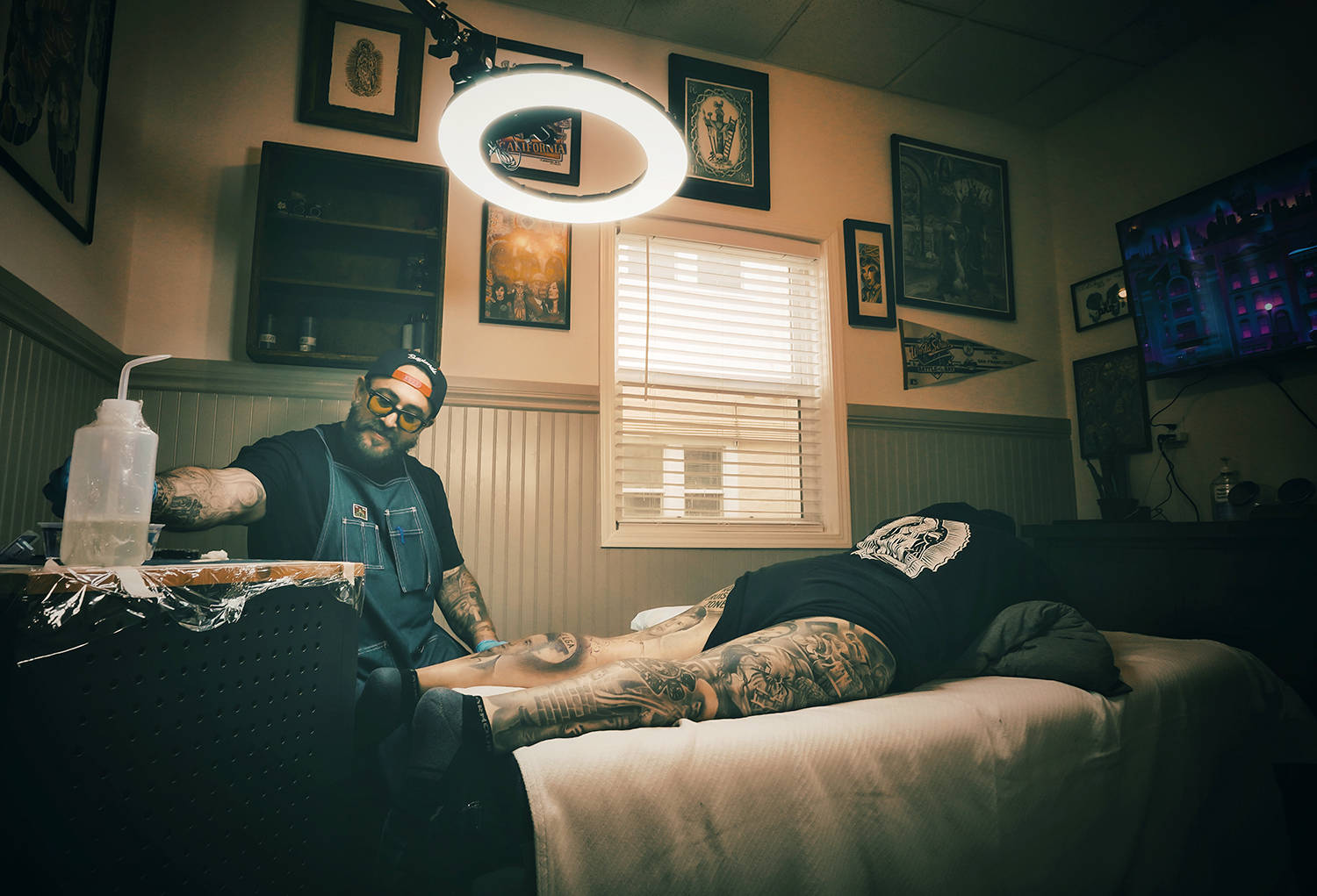
The black-and-gray expert completes a work on limb.
Is opening a business in Niles a full-circle journey?
Yes, a full circle; we’re finally back home.
The First Two Pictures courtesy of Eddy Reyes Sr
All Other Photos © The Tattoo Journalist / Scene360
